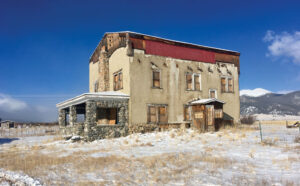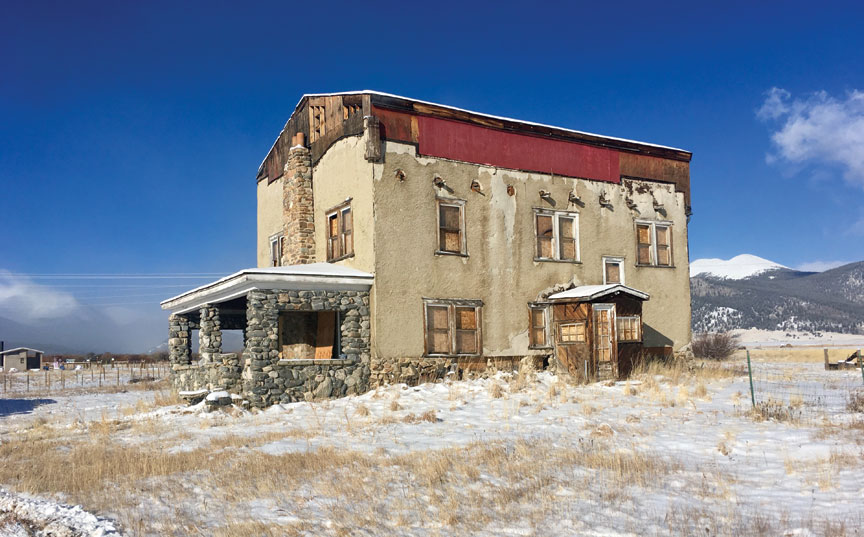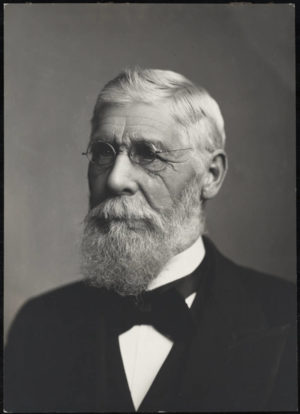By Kim Grant
For 90 years, the eclectic Tarryall-Cline Ranch house has stood proudly like a sentinel amidst a beautiful meadow just off U.S. Hwy. 285 in Park County. The main ranch house was built in 1928 by the ranch owner, Foster Cline, Sr., a prominent Denver attorney. Cline was the deputy district attorney in Denver from 1913 to 1917 and again from 1925-1929, and was later the regional administrator for the U.S. Securities and Exchange Commission.
The ranch house is a Park County landmark, located along the west side of the highway between the towns of Como and Jefferson, and was owned by, and associated with, Cline and his family for most of its history. Cline regularly visited but never intended to live there full-time, instead renting it out to a steady succession of ranch managers who operated hay and livestock businesses on site. The open space of the ranch grasslands, as well as the riparian and aquatic resources present, are all very important to wildlife habitats in South Park. A few years ago, 1,635 acres of the ranch on the west side of the highway which includes the main ranch headquarters complex, were purchased by Park County with the help of multiple public funding sources, including Great Outdoors Colorado (GOCO), the Colorado Habitat Stamp Program and the Park County Land and Water Trust Fund.
 Architecturally, the main ranch house is an example of the Pueblo Revival style with elements of the Spanish Eclectic style, which is very unusual and rare for a ranch house in Colorado from the first half of the 20th century. The main ranch house, while of wood frame construction, was built to appear as if it is made of adobe and stucco, influenced by the Native American pueblos and well as Spanish Colonial buildings in New Mexico and the Southwest. The Pueblo Revival style was part of the movement towards eclectic architectural styles popular in the early decades of the 20th century.
Architecturally, the main ranch house is an example of the Pueblo Revival style with elements of the Spanish Eclectic style, which is very unusual and rare for a ranch house in Colorado from the first half of the 20th century. The main ranch house, while of wood frame construction, was built to appear as if it is made of adobe and stucco, influenced by the Native American pueblos and well as Spanish Colonial buildings in New Mexico and the Southwest. The Pueblo Revival style was part of the movement towards eclectic architectural styles popular in the early decades of the 20th century.
A Historic Structure Assessment was completed for the property in 2011, and the main ranch house was noted to be in extremely poor condition, both inside and outside, due to age, poor drainage, lack of occupation and maintenance since its abandonment, and general exposure to the extreme weather elements present in Park County. In 2018, the ranch house was added to Colorado’s Most Endangered Places Program in recognition of the fact that the house needed urgent attention and as potential partners were emerging to save the property. The initial goals for the ranch house include stabilization and protection from the elements and potential vandalism, followed by the formation of partnerships to identify uses for the building that would complement the goals of the South Park National Heritage Area. These efforts are designed to preserve places where natural, cultural and historic resources come together to form a cohesive landscape and community experience.
In May 2018, CPI held a very successful Weekend Workshop that thoroughly cleaned the building, stabilized the foundation, replaced plywood window coverings with polycarbonate Clear Boarding material to secure the building and allow light into the interior spaces, and demolished a non-historic porch addition that was separating from the main building.
The site is actively being monitored for any natural or human impacts to the main building through the South Park Site Stewards Program and foundation repair is the next critical step. The end goal is to reuse the building for staff accommodations and potential visitor information center.
CPI and Park County have formed a solid partnership over the years that will be strengthened by other potential support groups such as the Colorado Department of Parks & Wildlife, South Park City/South Park Historical Foundation, Park County Historical Society, Park County Historic Preservation Advisory Commission, Town of Alma, Park County Department of Heritage, Tourism & Community Development, and the communities of Jefferson, Como, and Fairplay.
The Tarryall-Cline Ranch is one of 122 sites on Colorado’s Most Endangered Places list, which dates from 1997 and includes 47 properties considered “saved” while 43 are “in progress” and 25 are still considered on “alert” status. Only seven listed sites have been lost in 22 years of the program and even these offered important lessons for communities seeking to preserve the distinctive historic resources and places that give our cities, towns and rural areas their unique character and identity. CPI looks forward to working with Park County, and other Colorado communities, to build a better future with historic places.
Article and photos by Kim Grant, Colorado Preservation, Inc.



